| Columns Retired Columns & Blogs |
Paradigm Atom Monitor v.5 loudspeaker Measurements
Sidebar 3: Measurements
The little Atom is surprisingly sensitive, at an estimated 90dB(B)/2.83V/m, though this will in part be due to its rather tilted-up treble balance (see later). Though its impedance drops to 3.9 ohms at 197Hz and there is also a combination of 5.5 ohms and –42.5° capacitive phase angle at 148Hz, the Atom's impedance plot (fig.1) suggests that this speaker won't be that difficult to drive. Note, however, the disparity between the impedance in the lower midrange and that in the treble. Tube amplifiers with a highish output impedance will sound tilted-up with the Atom.

Fig.1 Paradigm Atom v.5, electrical impedance (solid) and phase (dashed). (2 ohms/vertical div.)
There are strong discontinuities in the impedance traces at 250Hz, 900Hz, and 19kHz. The last of these is associated with the tweeter's dome resonance; though this is a little close to the audible range, it should not in itself have any subjective consequences. The lower-frequency wrinkles, however, suggest the presence of cabinet resonances of various kinds. Investigating the panels' vibrational behavior with a simple accelerometer did indeed uncover a strong resonance at 254Hz. This was present on all surfaces, but was strongest on the sidewall (fig.2). The small radiating area of the Atom's panels will mitigate the audibility of this mode, but I would have expected it to lead to some midrange congestion at high playback levels. There is also a fairly strong mode present at 625Hz, though this is too low in frequency to correlate with the impedance glitch at 900Hz.

Fig.2 Paradigm Atom v.5, cumulative spectral-decay plot calculated from the output of an accelerometer fastened to the center of the cabinet's side panel (MLS driving voltage to speaker, 7.55V; measurement bandwidth, 2kHz).
Turning to the speaker's frequency-domain behavior (measured without the grille), the individual responses of the woofer (blue trace) and port (red), measured in the nearfield, are shown in the left half of fig.3. The woofer's minimum-motion point coincides, as it should, with the frequency of the "saddle" in the speaker's impedance-magnitude trace. (This is when the back pressure from the reflex port resonance holds the woofer cone still.) The port's maximum output actually occurs slightly lower in frequency, but note that while it rolls off smoothly above 100Hz or so, there is a severe peak present at 900Hz, the frequency of the impedance anomaly. The fact that the port faces away from the listener will work against this peak having subjective consequences, but I could hear it as a slight hoot overlaying the sound of pink noise.
The black trace below 300Hz in fig.3 shows the sum of the woofer and port outputs, scaled in the ratio of their radiating diameters and taking into account acoustic phase and the different distances from a nominal farfield microphone. The peak in the upper bass will be due in part to the nearfield measurement technique, but it does look as if the Atom's bass alignment is a little underdamped. The speaker's lower midrange seems a bit suppressed in this graph, but the response from 800Hz up is smooth and flat. There is some peakiness apparent in the top octave, however, "top-end sparkle," as Wes put it.

Fig.3 Paradigm Atom v.5, anechoic response on tweeter axis at 50", averaged across 30° horizontal window and corrected for microphone response, with the nearfield responses of the port (red) and woofer (blue) plotted below 1kHz and 300Hz, respectively, with the complex sum of the nearfield responses plotted below 300Hz (black).
Fig.4 shows the Paradigm's lateral dispersion, normalized to the response of the tweeter axis (which, as a result, is portrayed as a straight line). As is usual with small speakers, the Atom's radiation pattern is generally wide and even, though with a slight boost off-axis between 7 and 9kHz. There are also some anomalies at extreme off-axis angles between 800Hz and 1kHz, perhaps due to the influence of the port resonance. The top-octave peaks and suckouts in the on-axis response persist to the speaker's sides. In the vertical plane (fig.5), the balance doesn't change significantly over quite a wide (±10°) window centered on the tweeter axis, but a major suckout at the crossover frequency develops above that region. This suggests that high stands will work better with the Atom v.5s than short ones.

Fig.4 Paradigm Atom v.5, lateral response family at 50", normalized to response on tweeter axis, from back to front: differences in response 90–5° off axis, reference response, differences in response 5–90° off axis.

Fig.5 Paradigm Atom v.5, vertical response family at 50", normalized to response on tweeter axis, from back to front: differences in response 45–5° above axis, reference response, differences in response 5–45° below axis.
How all this added up in WP's listening room is shown as the red trace in fig.6. To generate this response, I used an Earthworks omni mike, a Metric Halo ULN-2 mike preamp–A/D converter, and SMUG Software's Fuzzmeasure 2.0 running on my Apple PowerBook. I took 10 response measurements for each speaker in a vertical grid centered on the position of Wes's head in his listening chair, and averaged them to reduce the effect of position-dependent room effects. The small peak centered on 70Hz, the larger one centered on 200Hz, and the suckout just above are all room effects that have not been eliminated by the spatial averaging. But other than those phenomena, the Atom's in-room balance is extraordinarily flat, at least up to 10kHz. Above that frequency, the on-axis peak in the top octave makes its presence known.

Fig.6 Paradigm Atom v.5, spatially averaged, 1/6-octave response in WP's listening room (red), with the spatially averaged, 1/6-octave response of the PSB Alpha B1 taken under identical conditions (blue).
But does this flat in-room response mean the speaker will sound flat? Unfortunately, it's not that simple. This room-averaged response includes contributions from both the speaker's direct sound and the room's reverberant field, which will be affected by such things as furnishings and drapes selectively absorbing high frequencies. A perfect speaker will thus give a treble response that smoothly slopes down a little with increasing frequency. Wes's small listening room is quite live, but it does have absorbent panels in the corners; to get a handle on what it does, I measured the samples of the PSB Alpha B1 that I reviewed in May, with both the speaker and microphone positions the same as for the Paradigm Atom v.5s.
The result is the blue trace in fig.6, normalized to give the same level at 1kHz to make comparisons easier. WP's room gives the little PSBs more support at low frequencies than does mine, and, as Wes noted, the Alpha B1 extends a little lower in the bass than the Paradigm. The same residual room effects can be seen below 500Hz, but the midrange is a little higher in level and the treble smoothly slopes down from left to right (though there is a hint in its response of the off-axis flare at the base of the tweeter's passband that I commented on in my review). If the PSB's trace represents what a speaker with a flat anechoic response will do in Wes's room, then the Paradigm Atom will sound rather tilted-up. Conversely, if the Paradigm sounds correct in this room, then the PSB will be too mellow, too dead-sounding. My bet is on the PSB, but read WP's auditioning comments for his take on the matter.
In the time domain, the Atom's step response (fig.7) indicates that both drive-units are connected with the same positive acoustic polarity, while the cumulative spectral-decay plot (fig.8) reveals some delayed energy at the frequency of the port resonance as well as a slight discontinuity at the top of the woofer passband. However, there is very little delayed energy associated with the top-octave peak.

Fig.7 Paradigm Atom v.5, step response on tweeter axis at 50" (5ms time window, 30kHz bandwidth).

Fig.8 Paradigm Atom v.5, cumulative spectral-decay plot at 50" (0.15ms risetime).
Considering its low price, the Paradigm Atom v.5 offers pretty good measured performance. But its particular balance—slightly excessive treble, slightly loose upper bass—will need some care in system matching.—John Atkinson
- Log in or register to post comments




































